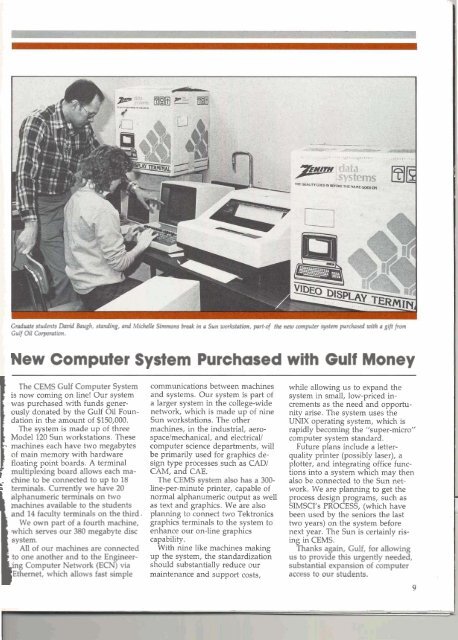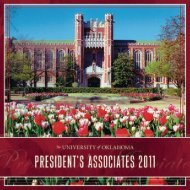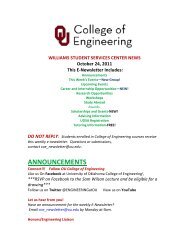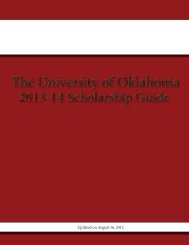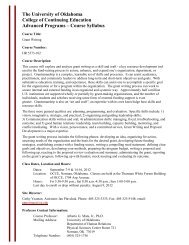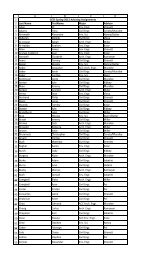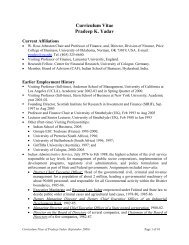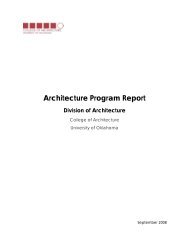1985 Spring - Alumni - University of Oklahoma
1985 Spring - Alumni - University of Oklahoma
1985 Spring - Alumni - University of Oklahoma
Create successful ePaper yourself
Turn your PDF publications into a flip-book with our unique Google optimized e-Paper software.
Graduate students David Baugh, standing, and Michelle Simmons break in a Sun workstation, part-<strong>of</strong> the new computer system purchased with a gift from<br />
Gulf Oil Corporation.<br />
New Computer System Purchased with Gulf Money<br />
I<br />
The CEMS Gulf Computer System<br />
js now coming on line! Our system<br />
was purchased with funds generously<br />
donated by the Gulf Oil Foundation<br />
in the amount <strong>of</strong> $150,000.<br />
The system is made up <strong>of</strong> three<br />
Model 120 Sun workstations. These<br />
machines each have two megabytes<br />
<strong>of</strong> main memory with hardware<br />
floating point boards. A terminal<br />
r multiplexing board allows each mai<br />
chine to be connected to up to 18<br />
i<br />
I which serves our 380 megabyte disc<br />
system.<br />
All <strong>of</strong> our machines are connected<br />
to one another and to the Engineering<br />
Computer Network (ECN) via<br />
Ethernet, which allows fast simple<br />
i terminals. Currently we have 20<br />
alphanumeric terminals on two<br />
machines available to the students<br />
and 14 faculty terminals on the third.<br />
We own part <strong>of</strong> a fourth machine,<br />
communications between machines<br />
and systems. Our system is part <strong>of</strong><br />
a larger system in the college-wide<br />
network, which is made up <strong>of</strong> nine<br />
Sun workstations. The other<br />
machines, in the industrial, aero-<br />
space/mechanical, and electricall<br />
computer science departments, will<br />
be primarily used for graphics de-<br />
sign type processes such as CADI<br />
CAM, and CAE.<br />
The CEMS system also has a 300-<br />
line-per-minute printer, capable <strong>of</strong><br />
normal alphanumeric output as well<br />
as text and graphics. We are also<br />
planning to connect two Tektronics<br />
graphics terminals to the system to<br />
enhance our on-line graphics<br />
capability.<br />
With nine like machines making<br />
up the system, the standardization<br />
should substantially reduce our<br />
maintenance and support costs,<br />
while allowing us to expand the<br />
system in small, low-priced in-<br />
crements as the need and opportu-<br />
nity arise. The system uses the<br />
UNIX operating system, which is<br />
rapidly becoming the "super-micro"<br />
computer system standard.<br />
Future plans include a letter-<br />
quality printer (possibly laser), a<br />
plotter, and integrating <strong>of</strong>fice func-<br />
tions into a system which may then<br />
also be connected to the Sun net-<br />
work. We are planning to get the<br />
process design programs, such as<br />
SIMSCI's PROCESS, (which have<br />
been used by the seniors the last<br />
two years) on the system before<br />
next year. The Sun is certainly ris-<br />
ing in CEMS.<br />
Thanks again, Gulf, for allowing<br />
us to provide this urgently needed,<br />
substantial expansion <strong>of</strong> computer<br />
access to our students.


